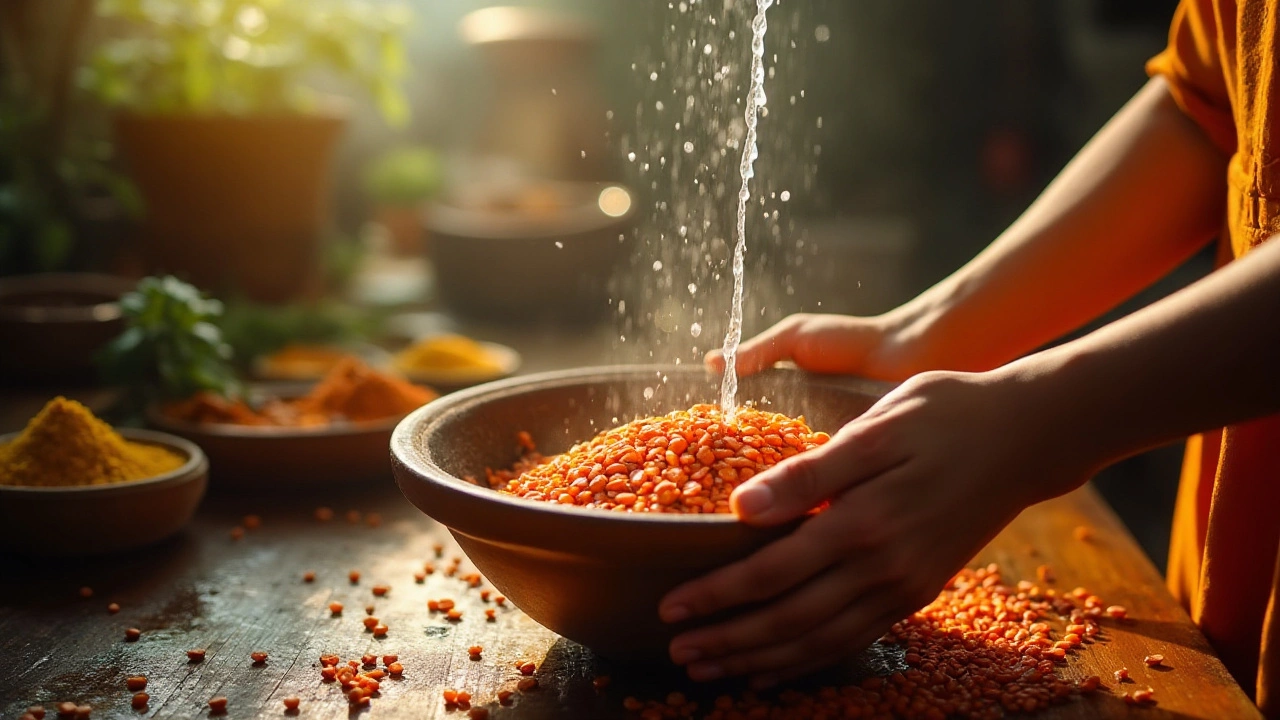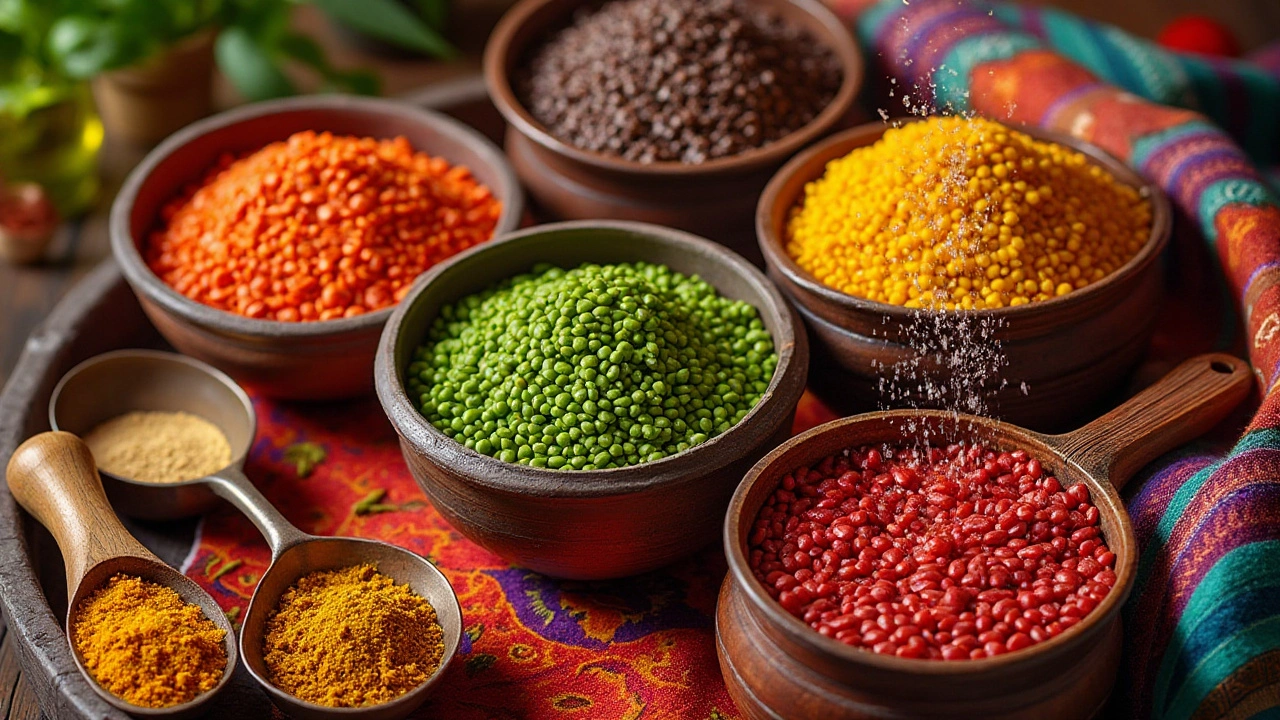The Importance of Rinsing Lentils Before Cooking: What You Need to Know
 Jan, 18 2025
Jan, 18 2025
Cooking is an art that often asks for seemingly small yet crucial steps that can make a world of difference. When it comes to lentils, one of those small steps is rinsing them before they make it into the cooking pot. While it might seem a negligible task, neglecting to rinse can alter the final taste and nutritional value of your dish.
In this guide, we'll walk you through why rinsing lentils is a step you should not skip. From improving taste and texture to avoiding potential contaminants, there’s more to rinsing than meets the eye. Let's unfold the secrets to ensuring your lentil dishes are not only flavorful but also healthier and wholesome.
- Why Rinse Lentils
- Potential Effects of Not Rinsing
- How to Properly Rinse Lentils
- Common Misconceptions About Lentil Rinsing
- Tips for the Perfect Dal
- Nutritive Benefits of Washed Lentils
Why Rinse Lentils
Many home chefs overlook the step of rinsing their lentils, often due to the mistaken belief that it's unnecessary or solely for cosmetic cleanliness. However, the act of rinsing these small, protein-packed legumes goes beyond mere appearance. It's about ensuring the safety, the flavor, and the nutritional aspect of your meal. Lentils, by their nature, are often dusted with dirt and debris as they are harvested and processed. Skipping the rinse means you may be cooking these unwelcome elements right into your food, potentially compromising the taste and texture of your dishes.
Another compelling reason to rinse lentils is the removal of anti-nutrients such as phytic acid. These compounds can bind minerals, making them less available for absorption in our bodies. By giving lentils a good rinse, you're not just washing away superficial dirt but also reducing these anti-nutrients to improve the overall nutrient absorption from your meal. If you're looking to maximize the health benefits of lentils, this step can't be overlooked. According to food scientist Harold McGee, rinsing pulses like lentils also helps in reducing some of the complex sugars responsible for the infamous 'bean bloat'.
"Proper rinsing and soaking can make a significant impact on digestibility," McGee states in 'On Food and Cooking'.
The benefits of rinsing lentils are not only nutritional but culinary as well. When lentils are free from surface grime and particles, they tend to cook more evenly. This is particularly important when consistency is key, such as with a silky dal. Lentils that haven’t been rinsed can release impurities during cooking, leading to a scummy froth that mars the aesthetic of the dish. Plus, rinsing helps prevent lentils from clumping together, allowing them to retain their shape and texture whether you're cooking a simple dal recipe or a more complex preparation.
It's equally interesting to note that rinsing contributes to the enhancement of flavor profiles in dishes. By washing away the earthy, musty, bitterness often associated with what's trapped on the surface of dried lentils, you create a cleaner canvas. This allows spices and herbs in your dal to shine through more vividly, offering a more defined and richer taste. Combined with the ease and efficiency that rinsing brings to the cooking process, it's a small effort for a large reward. Thus, embracing this basic yet essential step can lead to a far superior outcome than skipping it altogether.
Potential Effects of Not Rinsing
The practice of not rinsing lentils before cooking can introduce several unintended effects on both the quality of the dish and one's health. At the most immediate level, lentils often carry dust, dirt, and small stones that can find their way from farm to package. By skipping the rinse, you're essentially inviting these unwelcome guests into your meal. This contamination not only affects the overall cleanliness of your food, but can also impart a gritty texture that disrupts the creamy smoothness expected in dishes such as a well-cooked dal.
Moreover, lentils are known to come coated with chemical substances used during their production and storage, which can include pesticides and preservatives. Although typically within safe consumption levels, these chemicals can build up if not rinsed off. This is especially concerning for individuals with sensitivities or allergies. It becomes crucial to wash them thoroughly to minimize any potential residue, ensuring that your lentil dish remains both wholesome and hearty without unintended side effects.
Another overlooked factor is the presence of phytates in lentils, which are known as anti-nutrients. These compounds can hinder the absorption of certain essential minerals, like iron and zinc, within the body. While soaking is often employed to negate these effects, an initial rinse can help in minimizing their presence or enhancing their removal when you soak the lentils. As mentioned by nutritionist Sarah Brewer in a recent interview,
"Rinsing and soaking lentils can be pivotal in not only improving their digestibility but also in maximizing their nutritional potential."
Besides health considerations, skipping the rinsing step can actually affect the flavor profile of your dish. Lentils often carry a somewhat earthy or bitter coating, which diminishes once they’ve been properly rinsed. This simple wash enhances the legumes’ naturally mild and nutty essence, providing a neutral palette that skillfully mingles with delicate spices and seasonings of a traditional dal recipe. This balancing act is vital to each spoonful, resonating with layers of flavor rather than unexpected bitterness.
If you're keen on avoiding excess foam and cloudiness while cooking, another good argument for rinsing lies in starch removal. This coating can lead to murky broth and undesirably thick textures, especially if the lentils are intended for a soup or stew. By rinsing beforehand, clarity and consistency can be maintained, enriching appearance and mouthfeel alike. Some culinary experts even suggest a dual rinse—one before and another after boiling—to achieve the perfect finish.
A 2019 study published in the Journal of Food Safety showed alarming statistics where almost 29% of tested lentil samples contained physical impurities. The research underscores the pressing need for vigilance when using whole foods often assumed to be clean. Opting for the quick and effective step of rinsing not only avoids these potential contaminants but also paves the way for a safer, more flavorful dining experience as part of any beloved lentil dish.

How to Properly Rinse Lentils
Rinsing lentils might sound like an effortless task, but there are specific steps to follow to ensure that they are adequately cleaned before you start your cooking adventure. Skipping or rushing through this process can significantly affect both the flavor and nutritional value of your dish. Let's explore how you can make sure your lentils are thoroughly ready for the pot.
The first step is to gather your tools. You will need a fine mesh strainer or sieve, cold water, and a bowl large enough to contain the rinsed lentils. Start by pouring your lentils into the strainer, and shake them gently to allow any small debris to fall through. It's not uncommon for lentils to contain tiny stones or grit from being processed on a large scale. Position the strainer under running cold water, letting the water flow generously over the lentils. With clean hands, stir the lentils around in the strainer to ensure every part gets washed. This process should last for at least two to three minutes, as you visually inspect for anything unwanted.
Another proven method involves soaking the lentils for a brief period before giving them a thorough rinse. In a bowl, cover them with water and leave them to sit for about ten minutes. During this time, they will slightly expand, allowing dirt and chemicals to loosen. Drain and rinse them in the strainer afterward. Some experts suggest using filtered water for the rinse to avoid any contaminants in tap water—though this is optional.
Experts have often reiterated the virtue of good cleaning practices before cooking. As Helga Hasselbach, a well-regarded nutritionist in the field, has noted, "Proper rinsing of grains ensures that you're not only preserving the flavor but you're also safeguarding your health from potential contaminants." Such advice underscores the importance of meticulous cleaning, not just for lentils, but any form of dry grains.
For a comprehensive clean, it's worth considering additional rinses until the water runs clear. Cloudy or murky water often indicates remaining residues, so don't hesitate to repeat. This might seem tedious, but it's a worthwhile investment in ensuring your dish's quality. By practicing these steps diligently, you're set to bring out the best flavors and reap the full nutritious harvest of those humble little legumes.
Common Misconceptions About Lentil Rinsing
Rinsing lentils is often surrounded by a few myths and misunderstandings that might lead some to question its importance. One prevalent misconception is the notion that lentils are clean right out of the package and therefore do not need any prior preparation. While many brands pride themselves on quality packaging, the truth is that during processing and packaging, lentils can accumulate dust and particles you wouldn't want in your meal. Even when they look pristine, a quick rinse can reveal sediments and tiny pebbles mixed with the lentils.
Another common misunderstanding is that rinsing leaches out essential nutrients, leaving you deprived of the benefits that lentils provide. On the contrary, rinsing only removes the surface elements like dust and some anti-nutrients, such as phytic acid, which can interfere with mineral absorption. By washing your lentils, you’re actually enhancing their wholesome goodness, ensuring you absorb all the fiber, proteins, and amino acids these legumes offer.
Then there's the belief that rinsing causes lentils to lose their flavor. Some argue that the distinctive earthiness might diminish with excessive rinsing. But let's think about how flavor development occurs in recipes like a dal recipe. The spices and aromatic herbs layered into the dish are what truly define its taste. By cleaning your lentils, you’re allowing these flavors to shine, without fighting off any unintended dirt notes.
There are also myths about rinsing adding to the cooking time. Yes, the process adds a few minutes upfront, but the immediate benefits like removing anti-foaming starches and getting rid of particles mean you spend less time skimming off the frothy scum that might form if you skip washing. Moreover, lentil-rinsing skeptics might also argue against the need due to its impact on water usage. But consider this a small eco-cost in exchange for a hygienic and evenly cooked dish.
"Taking the time to rinse and sort lentils before cooking is not about over-thinking, but rather respecting each ingredient’s role in the dish." - Samuel Bolis, Chef & Culinary Educator
Myths, however, aren't just born without reason. Sometimes, one may find packaged lentils labeled as pre-washed. It's helpful, but despite that assurance, there's no harm in doing a quick rinse yourself. You're ultimately investing in both the quality of your meal and the health of those who'll enjoy it. Remember, for many, cooking is a labor of love and rinsing lentils is one of those acts that demonstrate culinary mindfulness.

Tips for the Perfect Dal
Creating the perfect dal is an art form that requires patience and attention to detail. It begins with choosing the right variety of lentils, as each type offers its own unique flavor and texture. For example, red lentils cook quickly and turn mushy, making them ideal for soups and stews. On the other hand, green lentils retain their shape and are great for salads and in dishes where you want to feel their texture. A well-balanced dal is colorful and aromatic, with spices like cumin, turmeric, and mustard seeds grounding the flavors, elevating the dish from simple to savory perfection.
Before cooking, rinsing your lentils is crucial. This step not only cleans off dust and small stones but also removes compounds like phytic acid, which can interfere with mineral absorption. During the rinsing process, keep an eye for any discolored lentils that need to be removed. “A little attention at this stage can make all the difference,” says Chef Raghu of Spice House. He adds,
“Rinsing gives you a clearer canvas to work on, allowing your spices and seasonings to shine without interference.”
To achieve perfect consistency, the cooking process should start with sautéing onions, garlic, and ginger—these are the holy trinity in dal preparation. A well-sautéed base enhances the flavor profile and richness of the dal. Follow this with the addition of your choice of spices, allowing them to bloom in hot oil, which unlocks their essential oils. Then, it's time to add the lentils and water. Remember, for every cup of lentils, you need at least 3 cups of water. Simmer gently, stirring occasionally, to prevent the lentils from sticking to the pot. The key is to let them cook until they reach a creamy consistency.
Poor seasoning can break an otherwise successful dal. Consider fresh ingredients such as finely chopped tomatoes and cilantro, or even a squeeze of lemon juice, toward the end of cooking. These add brightness and a touch of acidity that can balance the richness of the lentils. Consider checking the salt levels towards the end, as different salts can adjust the taste significantly. Also, sometimes a few adaptations are needed; if you find your dal too thick, don’t hesitate to add more water or if too thin, allow it to simmer longer to reach your preferred state.
Don't forget to garnish your dal. Fresh herbs like cilantro, a swirl of yogurt, or even a spoonful of ghee can elevate your dish to new dimensions. These finishing touches not only enhance flavors but also create a multi-sensory experience for those enjoying the meal. For those looking for a bit of crunch, experiment with crumbled papadam or roasted nuts sprinkled atop the dal. The journey to a perfect dal blends technique with creativity, where each step of the process plays an integral part in crafting a dish that warms both the heart and the soul.
Nutritive Benefits of Washed Lentils
When you think about the humble lentil, its small size might deceive you into underestimating its remarkable nutrient value. Lentils are a powerhouse of essential nutrients, but how you prepare them can make all the difference. One significant step towards unlocking their full potential is the simple act of rinsing. When lentils are thoroughly washed, they are cleansed of not just dirt and debris, but also compounds known as anti-nutrients. These anti-nutrients, like phytic acid and tannins, can interfere with the body's absorption of key minerals such as iron and zinc. By rinsing, you effectively reduce these barriers, allowing your body to access and utilize the minerals more efficiently, thus amplifying the nutritive benefits of your meal.
"Lentils are an extraordinary source of plant-based protein, providing about 18 grams of protein per cooked cup, making them an essential component in many vegetarian and vegan diets," says Dr. Paul Nicholson, a nutrition expert from the Institute of Food Research.
Incorporating rinsed lentils in your diet also offers an excellent fiber boost. Fiber is crucial for maintaining a healthy digestive tract and can help regulate blood sugar levels, which is beneficial for preventing chronic health conditions like type 2 diabetes and heart disease. Moreover, rinsed lentils have a more appealing texture, as excess starch and dust are removed. This not only enhances the mouthfeel but also the taste, making your dishes even more satisfying. Removing that outer layer of dust and impurities allows the true flavor of the lentils to come through, which can elevate a simple dal recipe into a culinary delight.
The nutritional benefits do not stop there. Lentils are also rich in folate, a B-vitamin critical for producing and maintaining new cells, making them especially important during periods of rapid growth, such as pregnancy and infancy. A single cup of cooked lentils provides nearly 90% of the daily recommended intake of folate. During the cooking process, washing lentils ensures that they cook evenly, which is key to preserving the maximum amount of nutrients.
| Nutrient | Amount per Cooked Cup |
|---|---|
| Protein | 18 grams |
| Dietary Fiber | 15 grams |
| Folate | 358 micrograms |
| Iron | 6.6 milligrams |
Finally, let's not forget the environmental aspect. By washing lentils, you not only prepare them better for your body but also reduce the chances of cooking with unwanted pesticides and contaminants, making your meal not only healthier but also more eco-friendly. Every step we take towards better food preparation practices is a step towards sustainability and improved health. So, the next time you’re ready to cook your favorite dish with lentils, remember that taking a moment to rinse them could make all the difference, not just in taste and texture, but in your nutritional intake as well.
